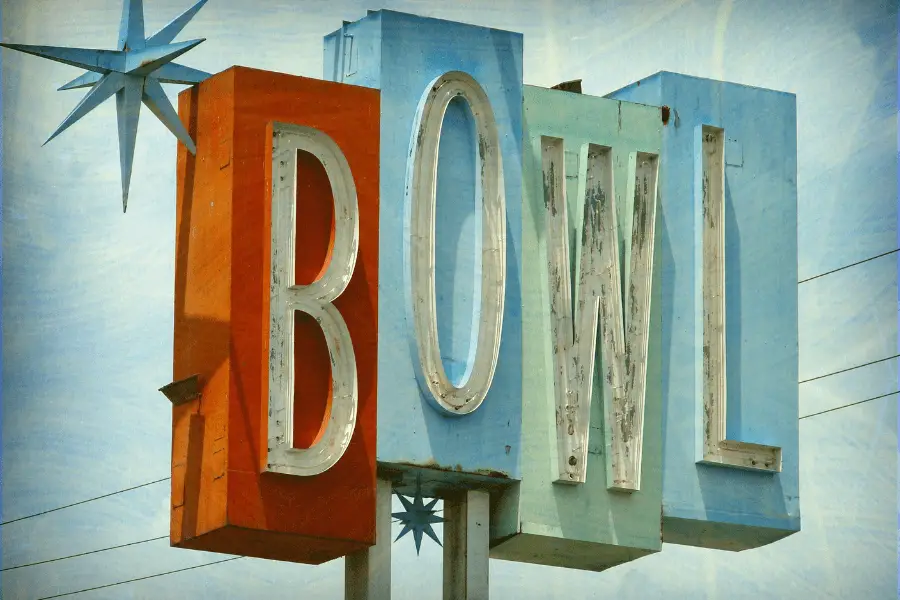What is going on with Bowling? Is it past its prime, is it dying, or is it still popular?
Is Bowling Dying
In the 1980s and 1990s, the bowling industry panicked because people could watch movies at home instead of going bowling. It was also a time when people started getting cable and computers. Then came the internet.
The large bowling companies and organizations (PBA, ABC – now the USBC, AMF, Brunswick) were concerned that all of these new options for people’s attention could cause a decline in their sport.
They were so wrong.
Of course, these new entertainment options did, in fact, decimate their industry. What they didn’t realize is that they were about 20 years too late to begin to worry. Their sport peaked in America in the mid 1960s and it has been on a downward slope ever since.
Bowling In The USA
Bowling is not dead in the USA, nor is it about to be. The industry, in its entirety, is still worth about $6 Billion annually. You can still likely find a bowling alley somewhere near you, and new bowling balls and other gear are introduced each year. The bowling industry produces enough cash to last for quite a while.
However, other figures need to be taken into consideration to grasp the extent of the downward slope of the industry:
In the mid 1960s there were about 11,900 bowling alleys in America. The population of America was 193 million people.
As of January 2022, there were 2,849 bowling alleys in America. The population of America is 332 million people.
Please don’t attribute this collapse in the number of bowling alleys to be the result of the pandemic. From 1998 to 2013, the number of bowling alleys decreased from about 5,400 to about 4,000.
Bowling leagues are in steep decline as well. Over 7 million people belonged to bowling leagues in 1963. In 2022 that figure is under 2 million people.

What About Professional Bowling?
During the 1950s, 1960s, and 1970s, professional bowling was a popular sport. Bowling was regularly televised and many people made their living as a professional bowler. Top bowlers made twice as much salary as their NFL counterparts, and many were household names.
Today, professional bowlers average under $44,000 per year. Of course, the very top bowlers, such as current champion Jason Belmonte, earn far more.
Kyle Troup earned about $500,000 in 2021. This is by far the most ever earned by a PBA bowler. Compare that to the $45 million earned by Patrick Mahomes in the NFL for 2021. The 2021 average NFL salary was $860,000 and the league minimum was $435,000!
In 2020, the 10th highest paid PBA bowler earned just under $72,000, and the 20th ranked PBA bowler earned $41,050. The average salary for all Americans in 2020 was $56,310. Only a dozen or so bowlers earned above the national average salary.
Why Did Bowling Decline
This topic is contentious and deserves its own article. No one knows exactly why, but most bowlers can certainly identify some of the factors:
- Television has improved dramatically since the mid 1960s, from blurry black and white to color to digital to HD; this has made fast moving sports like football into a much better viewing experience
- The price of bowling, whether per game, per hour, or the cost of equipment, increased at a greater pace than inflation
- Industry has declined in America since the peak of bowling, altering the social and economic structure that supported the bowling industry
- Bowling technology, especially with bowling balls, changed rapidly, which made keeping up expensive and a chore
- Bowling alleys aged, and many of them aged poorly, while the tolerance for a less than stellar facility among Americans has disappeared
- Casual bowlers were not always welcomed at bowling alleys
- The internet, streaming shows and movies, and computer gaming are viable alternatives for young people; bowling did not compete with Fortnite in 1965
Hope For The Future
As noted above, bowling alleys and bowling leagues are both in a 50+ year decline. It seems likely that the number of alleys, the number of leagues, and the number of bowlers will continue to decline for the foreseeable future.
Recreational bowlers were once shunned by alleys and scorned by league bowlers. These were the non-serious interlopers that would show up unscheduled at alleys, rent shoes, and use bowling balls owned by the alley and just play a few games for fun. They were considered to be a distraction to the league bowlers.
Now, recreational bowlers are seen as the savior of bowling.
Historically, bowling was firmly rooted in the middle class – blue collar workers who socialized in their bowling leagues. In 1937, there were 3,000 bowling leagues in the industrial city of Cleveland alone!
In the 1950s, the cost for a game of bowling was under a dime. In 2022 that cost is over $7 per game. Bowling is now firmly white collar.
While the overall number of bowling alleys continues to decline, some new bowling centers do get built. However, they have very little in common with the older bowling alleys that are disappearing.
These new entertainment destinations, like those operated by Pinstack, are firmly aimed at date night and social gatherings for young, white collar professionals.
Bowling alone is not enough of a draw. There are no bowling leagues at these 21st century bowling alleys. Instead, you will find catered food, full bars, full dinner menus, arcades, obstacle courses, rock climbing, and more.
While the old school bowling alleys were not interested in the casual bowler, upscale casual bowlers are the only bowlers that these new facilities are interested in attracting.
Conclusion
Is Bowling A Dying Sport? No. The industry is still worth billions of dollars, and the latest iteration of bowling and high end bowling alleys promises a potentially bright future.
But the industry is morphing into something unrecognizable to bowlers from the past. The bowling industry of 2030 will likely have little in common with the bowling industry of 1960.
In 2022, the bowling industry is a blend of the surviving old school alleys and new entertainment facilities that include bowling as one of many attractions.
The days of massive bowling league membership are certainly behind us, but we may just be on the cusp of a trend with more and more people bowling occasionally, as part of their overall entertainment budget.
Hopefully, this will eventually stop the decline of bowling overall and lead to actually growing the number of bowlers in America – even if those bowlers only bowl occasionally.

